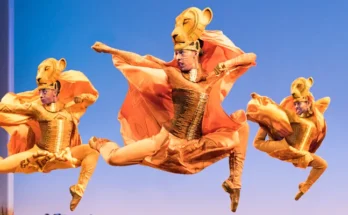It’s been said that one man’s trash is another man’s treasure. In the case of Stomp, that “trash” is a playground of sound and movement, a rhythmic cacophony of hands, feet, trash cans, lids, plungers, plastic bags, boots, brooms, buckets, dustbins, rubber tubing, Zippo lighters, sticks, hammers and hubcaps.
It’s loud, proud and amazingly inventive.
At its simplest, Stomp is an exploration of rhythm in everyday things. But Stomp – as theater, dance, music and performance art – is anything but simple. Its cast of eight to 12 indulges in an increasingly complicated combination of percussion and choreography in the course of each performance. To say that they dazzle and astound is an understatement. This is performance as tribal ritual, done in a steely industrial jungle.
Stomp obviously doesn’t spend much on wardrobe – the performers dress way down, in shorts, torn jeans, kick-butt boots, distressed Ts and kerchiefs, but in a week’s time – there are eight performances in five days here – they go through something like 30 brooms, eight trash-can lids, five short dustbins, 10 poles (6-ft., 6-in. each), 15 pounds of sand, four blocks of athlete’s chalk, 12 pairs of drumsticks, 200 liters of water, eight bananas and 12 boxes of matches.
What a journey it has been.
The Stomp phenomenon began in 1991 with two “buskers” on the streets of Brighton, England. Busking dates to the Middle Ages and is the British term for street performance that encourages passers-by to stop, look and listen. Twenty years ago, creators Luke Creswell and Steve McNicholas likely had no idea of the sensation they’d unloosed.
Stomp’s performers have become rock stars. The show, although a bit of a mongrel by design, has an undeniable pedigree. It has been seen in more than 350 cities in 36 countries. An off-Broadway production continues to sell out in its 15th season. Companies crisscross the United States and Europe as they have for years. And there is a sit-down company in London.
Stomp’s trophy case includes an Olivier Award (London’s Tony Award) for Best Choreography, off-Broadway’s Obie Award and a Drama Desk Award (New York) for Unique Theater Experience. It also was cited in Otis L. Guernsey’s highly respected industry tome, The Best Plays of 1993-94. In 2000, Stomp-ers performed for a millennial celebration on the steps of the Lincoln Memorial in Washington, D.C. Cresswell and McNicholas have been honored by the American Choreography Association and have Stomp-ed with the Muppets. Second Avenue at Eighth Street in New York now is called “Stomp Avenue”; Entertainment Weekly, in 2008, listed Stomp among its “New Classics: The 50 Best Plays and Musicals, 1983-2008,” alongside Angels in America, August: Osage County; Fences; Grey Gardens; and Rent.
Cresswell and McNicholas’ collaboration goes back to the early 1980s, when they belonged to a street band called Pookiesnackenburger and a theater group called Cliff Hanger. During that time, they concocted the famous “Bins” commercial for Heineken, the piece that eventually grew into Stomp’s show-stopping dustbin dance.
The show itself has changed as time stomps on. It “has evolved a great deal since its first incarnation,” McNicholas has said. “Every reworking has involved losing some pieces and gaining new ones but has always stayed true to the original premise of the show: to create rhythmic music with instantly recognizable objects and do it with an eccentric sense of character and humor.”
So you won’t ever see the same old Stomp, routine for routine. This go-round has been updated, restructured and given two new full-scale routines using paint cans, tractor-tire inner tubes (think bungees) and strip-lighting recycling containers that imitate a gourd-shaped South American percussion instrument known as the “guiro.”
The new and the used, so to speak, are performed by musicians, dancers, singers, percussionists and actors from California, Texas, Massachusetts, Hawaii, Maryland and, of course, England. Along with their audiences, they seem to share one commonality. As performer Michael Landis puts it, “The way of the beat came to my heart.”
::
Kathy Janich is an Atlanta theater artist and freelance writer. After years in daily newspapers, she’s found a joyous second career as an artistic associate at Atlanta’s Synchronicity Theatre. Visit synchrotheatre.com, please.



